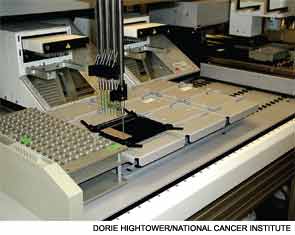
MADRID—Finding better and better treatments for patients with rheumatic diseases is a task that is generating interest from a variety of domains, and experts in proteomics and genetics here at the European League Against Rheumatism (EULAR) 2013 Annual European Congress of Rheumatology, held June 12–15, said research in these areas is shedding new light on treatment strategies, with the potential for more breakthroughs ahead.
Proteomic Technologies
The study of proteomics is becoming more robust in identifying proteins that can be used as biomarkers in osteoarthritis (OA), said Cristina Ruiz-Romero, PhD. Dr. Ruiz-Romero is a researcher with ProteoRed, a Spanish national network based in Madrid that is aimed at advancing the science of proteomics and promoting study and research in proteomics.
Analyses of proteins that are present in joint cells, cartilage, the synovial membrane, plasma, serum, and synovial fluid have been yielding success, with new proteins identified that weren’t previously associated with OA.
These proteins include retinol-binding protein 4 and proteoglycan 4 found in cartilage and OA serum; cartilage oligomeric matrix protein and lumican in cartilage, OA serum, and OA synovial fluid; and chitinase 3–like protein 1 in cartilage and OA synovial fluid, Dr. Ruiz-Romero said.
Proteomics, the simultaneous analysis of all proteins in a cell, tissue, or whatever specimen is being studied, has been refined with gel-free techniques—such as liquid chromatography/mass spectrometry—helping to reinforce or supplement gel-based techniques that can be costly and insensitive in detection of certain kinds of proteins.
Dr. Ruiz-Romero said that proteomics could prove to be an important tool helping to conquer two unmet needs: accurate diagnosis of OA and other rheumatic diseases at early stages and the monitoring of therapeutic strategies. The knowledge gained from proteomics might also help with the creation of personalized medicine programs.
But, she added, there are still limitations in the complexity of the analyses, including a full understanding of posttranslational modifications. Sensitivity continues to be limited, and the speed of the analyses also has room for improvement.
“Proteomic technologies have really a great power for the discovery of novel molecules with marker value for osteoarthritis and for all rheumatic diseases,” she said. Combining proteomics and genetic markers with more traditional markers is a good approach for diagnosis and monitoring of disease, but “a boost in the qualification and validation of these novel molecules is critically needed for their use in clinical routines.”
Crunching GWAS Data
Fransiska Malfait, MD, PhD, a researcher at the Center for Medical Genetics at the University of Ghent in Belgium, talked about the strides being made in genetics to get at the root causes of disease.
“Over the past five to seven years, GWAS [genome-wide association studies] have been very successful in identifying susceptibility loci,” she said. “Over 1,200 GWAS have been successfully completed, identifying over 1,000 loci for over 200 common diseases.”
There has been a shift from the “common disease–common variant” hypothesis, the idea that common diseases are caused by the cumulative effect of very large set of common alleles.
“Most variants identified so far in these GWAS account for only small increments in risk and can currently explain only a small proportion of heritability of many of the common diseases,” Dr. Malfait said.
This problem of “missing heritability”—the recognition that a significant amount of heritability remains unexplained, even by the best-designed GWAS studies—has given rise to the “common disease–rare variant” hypothesis, the idea that common diseases can also be caused by rare variants with big effects.
Finding these variants, though, requires analysis of “massive amounts of genomes,” said Dr. Malfait, which hadn’t been possible until the advent of next-generation sequence platforms, which have exponentially increased the number of sequence data that can be generated.
These techniques are gradually becoming more affordable, she said. Whole genome sequencing now runs about $5,000. Whole exome sequencing—identification of changes in DNA that are a cause of or are related to medical concerns—costs $1,000 to $2,000. “This is expected to still drop,” Dr. Malfait said.
Now, she said, the problem isn’t generating the genetic information. “The bottleneck here is the data analysis,” she said.
Researchers in her laboratory are trying to discover the genetic underpinning of a certain subtype of Ehlers-Danlos syndrome. They started with five unrelated families with at least two affected family members. They performed exome sequencing for at least two affected family members per family.
Researchers didn’t zoom straight in to the gene that is the cause; instead, they found four different kinds of gene variations in all five families. “We still have not found the causative variant,” she said. “So it’s very difficult data analysis.”
Dr. Malfait acknowledged the ethical concerns that come with the possibility of incidental findings that are unrelated to the disease in question. She said patient awareness is essential, but there are no real guidelines, and institutional policies vary on this subject.
Dr. Malfait said that, so far, she hasn’t found many whole-genome or whole-exome sequencing studies for rheumatic diseases. “However, I am convinced that in the coming years, … novel disease genes will be identified through these studies,” she said.
Tracking Protein Fingerprints
In another presentation, Anne-Christine Bay-Jensen, MSc, PhD, the head of Rheumatology for Nordic Bioscience, a biotech company in Denmark, talked about the emergence of “protein fingerprints,” a kind of biomarker that can help treatment strategies in rheumatology.
Protein fingerprints end up in the serum as a result of downstream inflammatory signaling—pathological enzymes are generated, causing the release of small but tissue-specific protein fragments that can be used as biochemical markers, Dr. Bay-Jensen said.
Use of these markers might help make up for deficiencies in the use of more traditional biomarkers, such as cytokines. Cytokines can often be nonspecific and can cause changes that are due to the total load of many types of cytokines, rather than due to a specific type.
Research has found correlations between these protein fingerprints and efficacy of treatment. In one study, they looked at a combination of protein fingerprints—C3M, CRPM, MMP3, C1M, and C2M—in RA patients on tocilizumab to try to identify responders and nonresponders (Bay-Jensen et al, submitted for publication).
Once the patient population was retailored, based on the protein fingerprints, the response rate for the group rose from 27% to 54%.
“This is what we want to know,” Dr. Bay-Jensen said. “We want to select the right treatment for the right patient.”
Thomas Collins is a freelance medical writer based in Florida.
